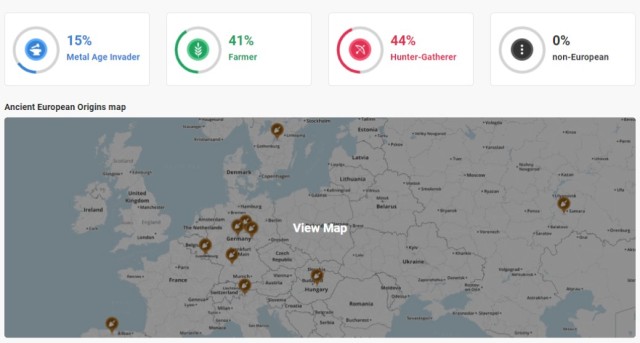Updated July 28, 2017
My curiosity of DNA genealogy testing started about seven years ago. I took the Family Finder test from Family Tree DNA, with hope that I could make some major breakthroughs.
So far, I haven’t made any major breakthroughs but it will take some more time. I have more hope that Family Tree DNA will get me at least one major breakthrough because it is the only company out of the three major testing companies that sends its DNA tests to Russia and Ukraine, in addition to all areas of the former USSR.
What type of information is provided on matches?
Customers get the following information on their matches: name, e-mail address (a few choose not to post their e-mail addresses), family tree (some don’t post their trees), match date, relationship range, shared centimorgans (specks of DNA shared between matches), longest block of centimorgans, and ancestral surnames (those in bold are shared or sound similar between matches).
You can see how this looks at the bottom of this page.
How does Family Tree DNA predict chances of being related?
Matches are listed as parent/child; uncle/aunt/nephew/niece; grandparent/grandchild; 1st to 2nd cousin, 2nd to 4th cousin; 3rd to 5th cousin; 4th cousin- remote cousin; and 5th cousin- remote cousin.
How often do you get matches?
Lately, I get at least 10 matches throughout each month. I have 337 matches from the past six and a half years. Both of my parents’ families came from Russia and Ukraine in the early 1950s to the USA. My mother’s Russian cousin, who has a father with British ancestry, has 685 matches from the past two years. My father’s Russian cousin, who has a mother with Jewish ancestry, has 1,321 matches from the past 5 and a half years.
How many of your matches have ancestors from Russia or Ukraine?
A high portion of my matches have ancestors from Russia, Ukraine, Belarus, Lithuania and Finland. A noticeable portion of my matches live in Russia. The same goes for my mother, aunt, uncle and four Russian cousins.
How close are your matches?
I have 3 matches for 2nd to 4th cousins, 9 matches for 3rd to 5th cousins, 29 4th cousins- remote cousins and the rest are 5th cousins- remote cousins. For my mother, she has 3 matches for 2nd to 4th cousins, 6 matches for 3rd to 5th cousins, 30 matches for 4th cousins- remote cousins and the rest are 5th cousins- remote cousins.
Do you have surnames in common with your matches?
I have a handful of matches with shared surnames of Germanic ancestry but I can’t connect our family trees. I have one match with a shared Russian surname from a great-grandfather but the match isn’t close enough to confirm the relationship. My father’s cousin has a shared Russian surname from her maternal grandmother with a 4th cousin but my cousin doesn’t have enough information to connect the family trees.
How friendly are matches in giving information?
Everyone but a random few have responded to my e-mail messages about exchanging information.
What tools does Family Tree DNA offer in searching, sorting, filtering and noting matches?
Customers can check whether they have shared matches with each person listed as a match. Also, matches can be sorted by various relationship ranges, X-chromosome matches (from a maternal line), common surnames, known relationship, longest DNA block, DNA shared and date matched. Matches can be searched by name and ancestral surnames. Notes also can be placed on each match.
If parents tested their DNA, their children can have their matches filtered as maternal or paternal matches and matches share by both parents.
Family Tree DNA has two other tools: chromosome browser and matrix. Chromosome browser shows where up to 5 matches have shared DNA on the 22 and X chromosomes. This helps determine the ancestor in common. Matrix allows up to 10 matches to be compared for their Family Finder relationships in a grid.
Does Family Tree DNA give an ethnicity breakdown?
Yes. It breaks down ancestry from its 24 reference populations and puts it on a global map. Matches with similar ethnicity are listed on the bottom left of the map. A filter is provided to compare other matches, based on their closeness in relationship.
What other information does Family Tree DNA provide?
It gives the three most common ancestral surnames that come from the matches and the number of matches who have those names.
Family Tree DNA also gives percentages of ancient European origins (hunter-gatherers, early farmers, and Metal Age invaders) and a map of the origins.
Does Family Tree DNA have forums to help figure out the DNA test and its results?
Yes. These forums are open to the public and are very helpful in understanding the various tests Family Tree DNA offers and figuring out how to find connections with matches.
Related posts:
A Russian-American’s inside view of the new AncestryDNA test
A Russian-American’s insider view of the MyHeritage DNA test
A Russian-American’s insider view of the 23andme Autosomal Test



My uncle’s results Family Tree DNA (he is my late Father’s identical twin – my uncle is now deceased)
Results: R1a1 SRY10831.2+ L122+, M417-, L168-, M198-, L566+, L457+
Family Finder location results show 45.91% Europe (Russian, Finnish) 54.10% Western Europe (Orcadian, French) (09.04% margin of error)
Genealogical research on my uncle’s father is Polish/Russian (same villages Bokinichi / Dubnovichi currently located in Belarus) back to late 1700s and an earlier connection to the family in another village in the same area back to 1500s and his mother Polish/Russian in the late 1800s but family most likely originally from somewhere else as Stojan doesn’t seem Polish or Russian
LikeLike
That’s great you have been able to research that far back. Family Tree DNA is updating its Population Finder (ethnicity breakdown) in about a week or so.
LikeLike